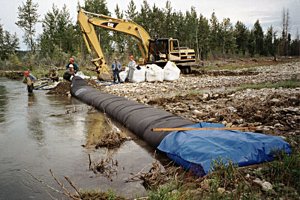| Home |
|
|
|
|
Online Store |

|
|
|
Sign up to receive our free Water Utility Tip of the Day
If you're visiting our website and the layout looks wrong, try going to your address bar and change the address from "https" to "http". We recently added SSL security to our site, but it is causing some pages to appear without formatting.
If you're visiting our website and the layout looks wrong, try going to your address bar and change the address from "https" to "http". We recently added SSL security to our site, but it is causing some pages to appear without formatting.
The need for convenient, economical, and easily-deployable water-control systems has traditionally been satisfied either through the use of earthen barriers or -- in emergencies -- by the use of sandbags. Both of these methods of water containment come with serious disadvantages. Earthen barriers can be slow to construct and are often quite disruptive to the nearby environment. They often require geotextile reinforcement to maintain their stability, and they are not easily dismantled when they are no longer needed. Sandbags, by contrast, are more flexible to deploy, but they require huge amounts of manpower and can create health and environmental hazards of their own. They can, for instance, become contaminated and remain in place as a harbor for unwanted pathogens, parasites, and rodents. Moreover, sandbags are often in short supply during an emergency and getting the bags and the sand from one location to another can require lots of traffic by heavy trucks.
Portable dams provide an appealing alternative to conventional methods of water containment and diversion. Portable dams are lightweight and easy to handle, making them quick and simple to deploy with very little labor required. Once the geomembrane portable dam is in place, it can be rapidly filled with a portable pump using the water that's already available on-site. And when it's time to remove the portable dam, it can be drained rapidly and removed again with a minimum amount of manpower required.
 Portable dams (sold as the Aqua Dam from Layfield) are useful for a wide range of applications:
Portable dams (sold as the Aqua Dam from Layfield) are useful for a wide range of applications:
last revised March 2009
Portable dams provide an appealing alternative to conventional methods of water containment and diversion. Portable dams are lightweight and easy to handle, making them quick and simple to deploy with very little labor required. Once the geomembrane portable dam is in place, it can be rapidly filled with a portable pump using the water that's already available on-site. And when it's time to remove the portable dam, it can be drained rapidly and removed again with a minimum amount of manpower required.
 Portable dams (sold as the Aqua Dam from Layfield) are useful for a wide range of applications:
Portable dams (sold as the Aqua Dam from Layfield) are useful for a wide range of applications:
- Flood control for rapid and easy deployment
- Pond and lagoon liner repairs
- Water containment for bridge repairs, diffuser installations, and sewage-system construction
- Seawall repair
- Silt containment and sediment collection
- Erosion control, including both diversion and containment
- Water storage for livestock, wildlife protection, and agricultural uses
- Stream crossings and temporary footbridges
last revised March 2009



